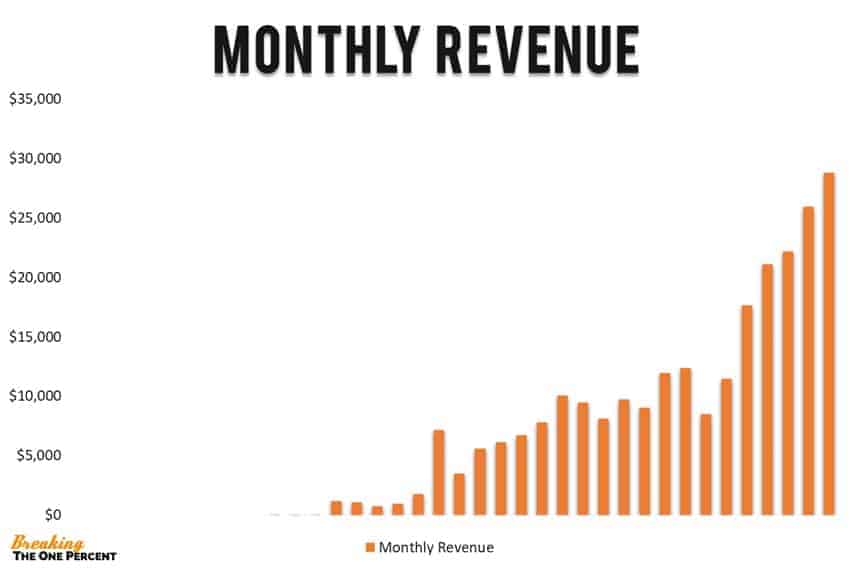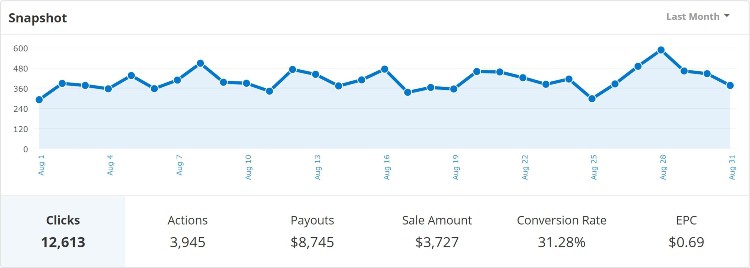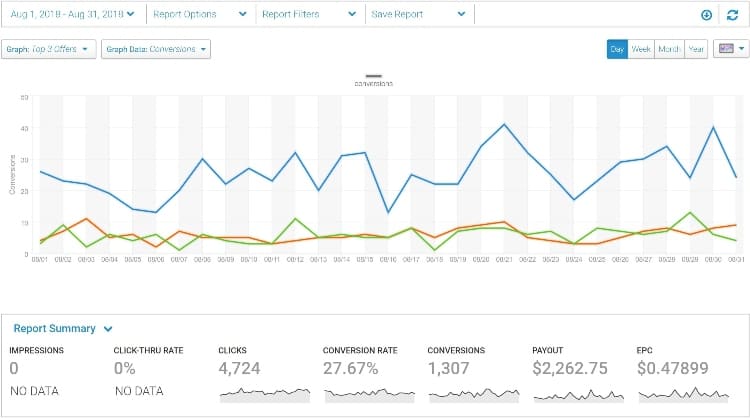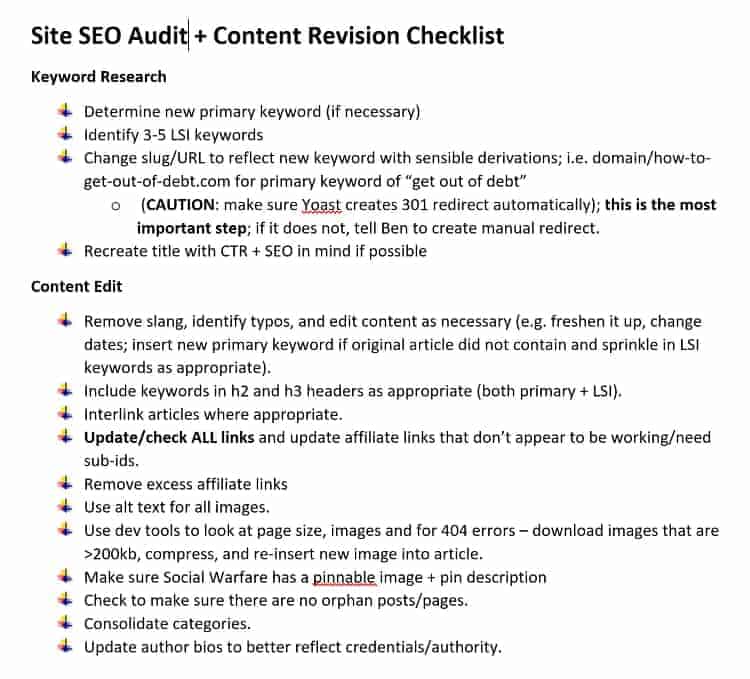How We Made $28,785 Blogging This Month (August 2018)
Our blog income reports aim to provide legitimate value to beginner and advanced bloggers looking to up their monetization game, including answers to questions from our blogging community.
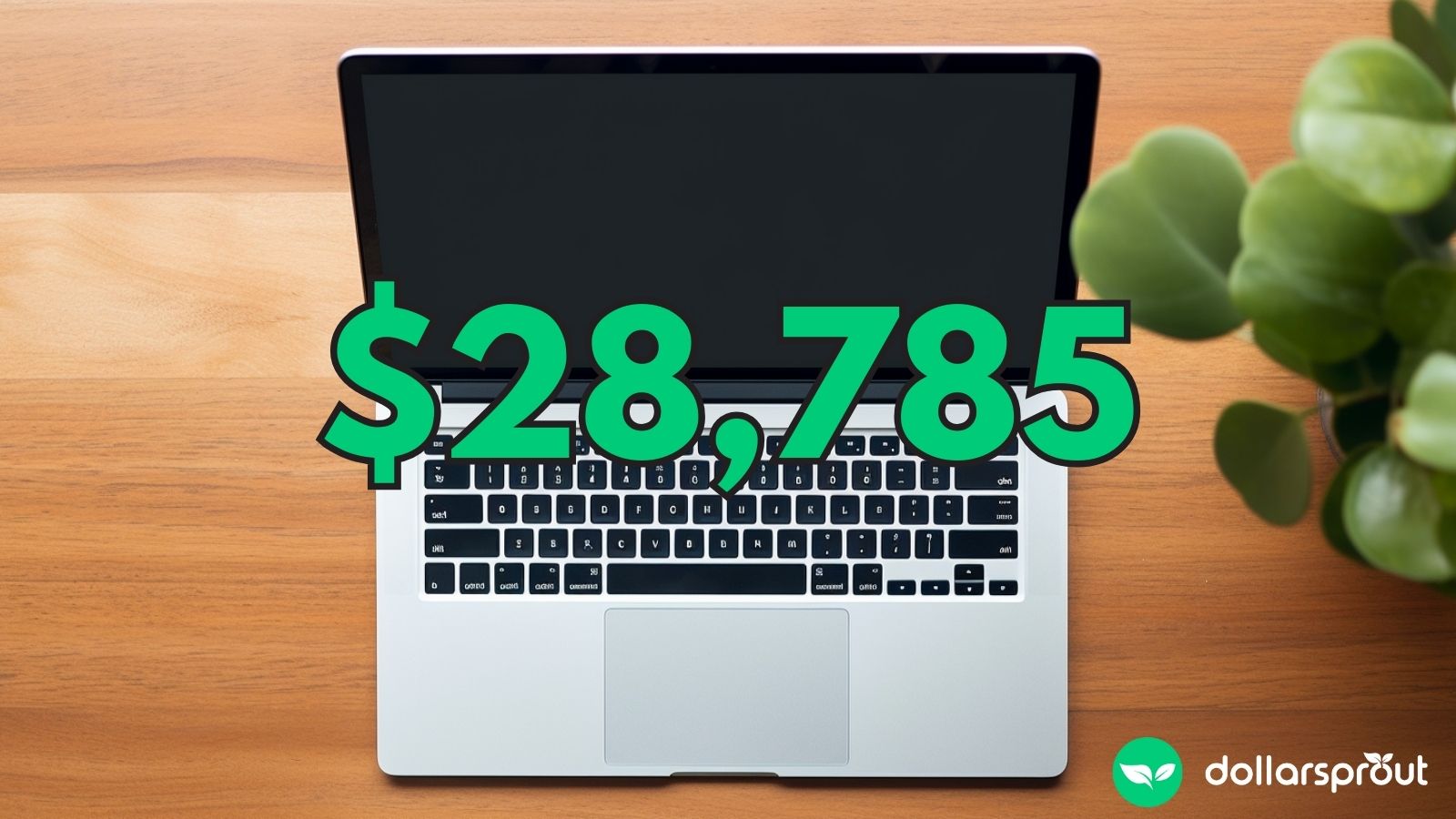
Some of the links on DollarSprout point to products or services from partners we trust. If you choose to make a purchase through one, we may earn a commission, which supports the ongoing maintenance and improvement of our site at no additional cost to you. Learn more.
He loves me…he loves me not. He loves me…he loves me not.
It’s the best analogy I could come up with to describe Jeff and my relationship with regular blog income reports.
Sometimes we’re feeling super inspired. Other times, we’re drowning in unfinished work, and while still inspired, an income report is somewhere near the very bottom of our to-do list.
Now is closer to the latter of the two.
Alas, we’ve had some super cool breakthroughs over the last few months, among many other things to share, and the will of the people cannot be denied:
There will be an August 2018 blogging income report. Here we go.
How We Made $28,785 Blogging in August 2018
Income Growth
August was a hot month for us in more than one way. Namely, because it was our best month ever in terms of gross blogging income. It was ~10% better than last month, and ~63% better than our last income report in April (just 4 months ago!).
After 42 months of “blogging,” we’re thankful to have finally figured out a half-decent system that seems to work for us. The air quotes around blogging exist namely, because we didn’t really understand the actual concept of blogging until about August of 2016…a full 18 months after we started on our original website, VTX Capital (disclosure: it is now deceased).
I’ve mentally blocked those dark times from my mind, but let’s just say our earnings did not exceed $46.29 — an hourly return of less than $0.01 per hour.
Through a little luck (and a whole lot of stubbornness) we learned the way most people do — a stupid amount of trial and error.
Staying true to our roots, this month’s income report aims to provide value for you, along with a little insight into the almost surreal way blogging allows us to make money online.
Additional Blog Income Reports
January 2017: $7,158
March 2017: $14,087
June 2017: $7,768
July 2017: $10,062
December 2017: $11,946
January 2018: $12,372
April 2018: $17,640
August 2018: $28,875 <-- current month
October 2018: $61,915
December 2018: $104,097
February 2019: $347,675 (last published income report for privacy purposes
Income Breakdown
This month, we took affiliate marketing to a new level (for us anyway). It comprised the vast majority of our income and somewhat differentiates us from other high(er) earning bloggers who typically find success through product sales and email marketing. As with most bloggers, we utilize several affiliate networks and join several affiliate programs within each network.
Our exact breakdown by income stream:
- Affiliate marketing: $27,836
- Ads: $638
- Course sales: $311 (net profit)
Our income for this month looks a little like this:
Impact Radius
Blue Media Ventures
iGain
CJ
Other Income
- Smaller affiliates (Dosh, Ibotta, Ebates, etc): $4,357
As previously mentioned,
- Ads: $638
- Course sales (profit): $311
Total: $28,785 in gross revenue
Have you started a blog yet?
Blogging is an inexpensive way to potentially change your life. It'll take time, but for less than $3/month you can build and launch your own blog. It's exactly what we did just a few short years ago and it's hard to believe just how far we've come. We did it with 0 experience, 0 technical knowledge, 0 help.
What we did have: The stubbornness to not give up and an insatiable will to keep learning.
Interested? Hosting companies such as HostGator can have your website up and running in less than 15 minutes. It can be a scary, nerve-wracking feeling. My recommendation: Jump headfirst into it.
Expenses Breakdown
Payroll: $5,543
This includes freelance writers, virtual assistants, content editors, and a third-party SEO audit. Something worth noting is that our expenses in this area will drastically increase in the near future. Right now, Jeff and I have our own health insurance plans. This will likely change in the next month or two as our company will soon be offering benefits packages to our full-time employees (it will be a cost-savings measure for us personally, but will cost the company as it expands to other employees).
Facebook ads: $3,102
Hosting-related services (billed annually): ~$105/month
Email marketing: $119
Premium services (billed annually): ~$100-$200/month
These are typically plugin-related. Think backups, theme support, security, social sharing, etc.
Total expenses: $8,969
Total Profit:~$19,816
Areas for Growth
Affiliate Marketing
Although there are other affiliate marketers earning six-plus figures, the reason it’s (less) popular as a revenue stream, among top bloggers, is because the revenue source (usually) requires such a high volume of visitors coming to your site each month. Think multi-six-figures in visitors to generate multi-five figures in income.
That being said, and perhaps against the mold, we went that route mostly because Jeff and I haven’t adjusted well to creating courses. I guess it’s a personality sort of thing or something.
While I’m proud of the content we create, I think we have a hard time focusing on a project that extends beyond 2 hours.
ADD, ADHD, blogging deficit disorder, whatever you want to call it, we’re just bad at staying focused on something that requires weeks to months worth of work. It also doesn’t help that we’re both perfectionists, and we continually try and optimize content that is already more than sufficient, making course creation take twice as long as it reasonably should.
Simply put, our strengths are much better suited towards tackling things that we can accomplish in little time blocks or “micro-projects.”
In fact, and much to Megan’s dismay (our senior editor), we actually put a course we’re over halfway through completely on hold for now.
That may sound silly, but I do think that one thing Jeff and I do well is pivot. Right now, at least financially speaking, traffic growth and sound affiliate marketing strategies are getting us a better return on our time. The absurd traffic growth is also helping us collect emails at a pretty good clip, which bodes well if/when we get around to finishing our course.
One of our biggest goals over the upcoming months is to continue to diversify affiliate offerings (so our eggs aren’t in one particular basket). We made over $11,000 from a particular affiliate this month, but that isn’t for lack of diversity (even if that affiliate were to fold, we can shift quickly to a comparable affiliate). It’s just something to think about, merely because you can wake up one morning and a company has ended their program completely.
Furthermore, we’re getting pretty good at regularly checking in with our affiliates and seeking feedback about the relationship/identifying areas for improvement. This regular email is also our foot in the door to negotiate commission increases.
Website Traffic
This was a particularly strong month for us, not necessarily from a numbers perspective, but in terms of month-over-month growth. A huge reason for this is an absolutely ridiculous focus on “the details.”
I’m talking SEO titles, H1 headers, social media titles, and putting thought into every single thing we do. I realized that while our content marketing game wasn’t terrible before, we had a ton of room for improvement. This meant completing a site-wide SEO/content overhaul. We needed to get more from our existing content.
It was painful, but Megan and I got through it (Jeff mostly focused on fresh content creation for DollarSprout while Megan and I did a complete overhaul for BTOP). We focused on freshening things up, fixing broken links, enhancing tracking, and curating new social media and SEO titles (getting better keywords in there and increasing CTR). It all matters.
The results were immediate:
By the numbers (Breaking The One Percent; launched October 2016):
- June Google traffic: 12,800
- July Google traffic: 14,700
- August Google traffic: 24,700 (93% growth since June; SEO audit started in early July)
By the numbers (DollarSprout; launched October 2017):
- February Google traffic: 2,850
- June Google traffic: 43,800
- July Google traffic: 65,400
- August Google traffic: 84,400 (2863% growth since February)
If you’ve been around the blogging scene for a while, you probably understand just how insane those numbers are. We virtually doubled our organic traffic in 2 months with 0 (or close to 0) significant new backlinks. (We don’t do a lot of active linkbuilding for BTOP, mostly because our efforts are focused on DollarSprout linkbuilding at the moment. Any acquired backlinks were entirely passive in nature.)
As you can see, you can get insane SEO growth by cleaning up your on-page SEO.
P.S. Here’s a short summary of what Megan and I did for our site-wide SEO audit (this isn’t everything, but you may find it useful). Reminder: be careful about redirects. I went through and removed every single internal 301 redirect from our site when it was all said and done.
Areas of Focus
It may come as no surprise that, looking forward, our areas of growth and areas of focus are pretty much one in the same.
Notably, our commitment to revamping our older content is about to continue on DollarSprout (our personal finance blog).
Now that we’ve finished the BTOP content audit, Jeff and Megan plan on clearing out our finished content backlog (we have several drafts that are nearly ready for publishing) while I meticulously go through all of our existing content (on DS).
This will allow us to double down on our social media efforts, which concurrently has a positive synergistic effect on our SEO efforts. Social media referral traffic signals popularity and gives Google session/quality data about our content.
The end result is better SEO, more content, increased organic traffic, and increased social referrals. Furthermore, the focus on SEO/linkbuilding helps grow our domain authority, a metric that Pinterest probably takes into account in its sorting algorithm.
Facebook Group Questions
If you’re not in our Facebook group for bloggers, you’re seriously missing out. It’s free to join and full of other knowledgeable and experienced bloggers who can help answer all your blogging questions.
One of the consistent themes within the group is that people are always asking questions. There are over 4,000 other bloggers in the group who can help answer them. If you need an answer at any hour of the day, there’s usually someone on 24/7 to chime in.
Sometimes people ask us specific questions about our business, and we like to answer a few of them in our income reports here.
When running ads on Facebook, what’s your starting budget? And how many A/B tests do you do initially?
There are a lot of directions you can take these two questions, so I’ll try as best I can.
My campaign goals almost always dictate how things go.
I like to run a lot of traffic campaigns. I think there was a lot of value in engagement campaigns back in 2016-2017, but those have been greatly devalued by Facebook’s recent algorithm changes. I highly advise against those now. The huge perk used to be the fact that you could get insane organic reach on paid ads due to people engaging with your ads. That’s simply not the case anymore.
Besides, at the end of the day, I want people on my site. I let their algorithms optimize to get people there as cheaply as possible. I optimize based on landing page views.
I always build lookalike audiences (LA) based on the traffic that has already been to an article. This is so I know I’m hitting an audience of similar, yet new, people. This also helps me avoid the extra cost of having to test audiences because 1-3% lookalike audiences almost always outperform any sort of other targeting options. I’ll further narrow my LAs with social proof and interest-based options (friends of friends, etc).
At that point, it’s just testing creatives and ad copy. Fortunately, Jeff is naive to my fairly sizable Facebook ad spend, so I have a little flexibility to create lots of variations and test them each for a few days before deciding which ones to turn off. It has taken a while to feel pretty comfortable with Facebook ads, but I expect our ad spend to exceed $10,000/month here shortly.
My budget, all in all, is determined at the ad set level by how well I can scale without it getting too expensive. Theoretically, I’ll scale ad sets to hundreds of dollars a day since some of our audiences will have over 1 million people. Typically, I’ll start at $5.00/ad set and scale 10%/day automatically.
If I know an article generates 10 cents/visit, getting a CPC at or near (ideally below) 10 cents/visit is a win. I don’t mind taking a small loss (<20%) in order to get traffic on our site/collect emails. There are also SEO benefits to having the traffic, which exponentially increases our ROAS.
For example, even if we take a 10% hit on immediate return, if our article ranks in 1-2 months, that could translate to a 10,000% ROAS.
For what it’s worth, I actually turn off our display ads on articles that I’m running Facebook ads for. I could probably recoup part of our ad spend merely by having ads running in the article, but we try to avoid them where possible. We don’t want to cannibalize affiliate income or sacrifice page speed.
Can you discuss how much time you’ve put into SEO and how many guests posts you’ve done to start seeing great results? How were you able to get those guest posts?
It’s virtually impossible for me to enumerate the amount of time we’ve spent on SEO, but I can tell you, generally speaking, what we spend our time on:
Besides general on-page SEO, we spend a good amount of time actively linkbuilding.
Usually, this comes in the form of guest posting, but we also do cold email outreach. Recently, Jeff actually had someone from Upwork draft a list of 1,000 personal finance/business blogs. After we received the list, Jeff, Megan, Meredith, and I plowed through it, sending personalized emails to nearly all 1,000 entities. This resulted in about 100 outright backlinks and/or guest post opportunities. I don’t have the exact data available (and I could probably turn it into a case study), but the actual figure is probably higher than the cited 100 figure.
Since guest posting is pretty time-intensive, we try and limit the number of them we take on. We generally only commit to guest posting on sites with a potentially rewarding domain authority coupled with good/great niche relevance.
Here’s an example of a guest post I did last month for Derek at Life and My Finances.
We also look for opportunities (via email outreach) to link-build with content similar to ours that we find on Pinterest. We’ve had success getting quality backlinks from HARO as well.
I’d love for you to share your thoughts on quitting a job to blog full-time before generating income. It’s something I’ve considered, so I’d love to know the honest opinion from folks who actually took the leap before their blog took off…then went back to a job…before quitting again.
I’m going to answer for Jeff on this one.
Don’t do it.
I’m all for people taking a leap of faith and starting their blog. I firmly believe that as long as you are committed to blogging for the long haul, and you’re willing to always keep learning, you will eventually make it.
Making it can mean something different to everyone. For us, it means establishing an actual media company. For others, it may mean a side hustle that generates a few hundred dollars each month, and that’s it.
That being said, not everyone will learn how to make money blogging and then actually follow through and execute the steps correctly at the same rate. Unless blogging is a field you have past experience in, I’d say forget about it. It will reasonably take months to years before you’re generating a consistent 4 figures per month. The bare minimum you’ll need to support yourself, let alone a dependent. Furthermore, you’d be siphoning income away from blog growth/re-investing back into your blogging business.
Some general tips for deciding when it’s a good time to dive in (all must be present):
- You have at least 6 months of living expenses saved.
- You have a separate emergency fund.
- Your blog is consistently making enough per month to support a reasonable living budget for you and/or your family.
Even this is an aggressive scenario in my opinion, but it does allow you to make the jump sooner if it’s something you’re dead set on doing.
For what it’s worth, Jeff had 12 months of income saved, but we were generating $0 in blogging income when he took the leap. The result, as you know, was him going back to work part-time for nearly a year while our blogging income finally grew to the point where it could support him and continued blog reinvestment.
Tying It All Together
For how long it took us to put everything together, it’s neat to be able to look back and say, for the most part, that a lot of our success emanates from our last 24 months of work.
It’s a good reminder that while 24 months is an incredibly long time for someone who is actually depending on their blogging income to pay the bills, it’s a fairly short amount of time in the grand scheme of things. Rome wasn’t built overnight. Neither will your blog be.
Patience is key. Tune out what is sucking up your time and find ways to increase your productivity during whatever time you can devote to your blog.
If you get 1 hour a day to work, make it the most productive 1 hour you possibly can.
Related: Our Last Blog Income Report: How We Made $347,675 Blogging in 2 Months


